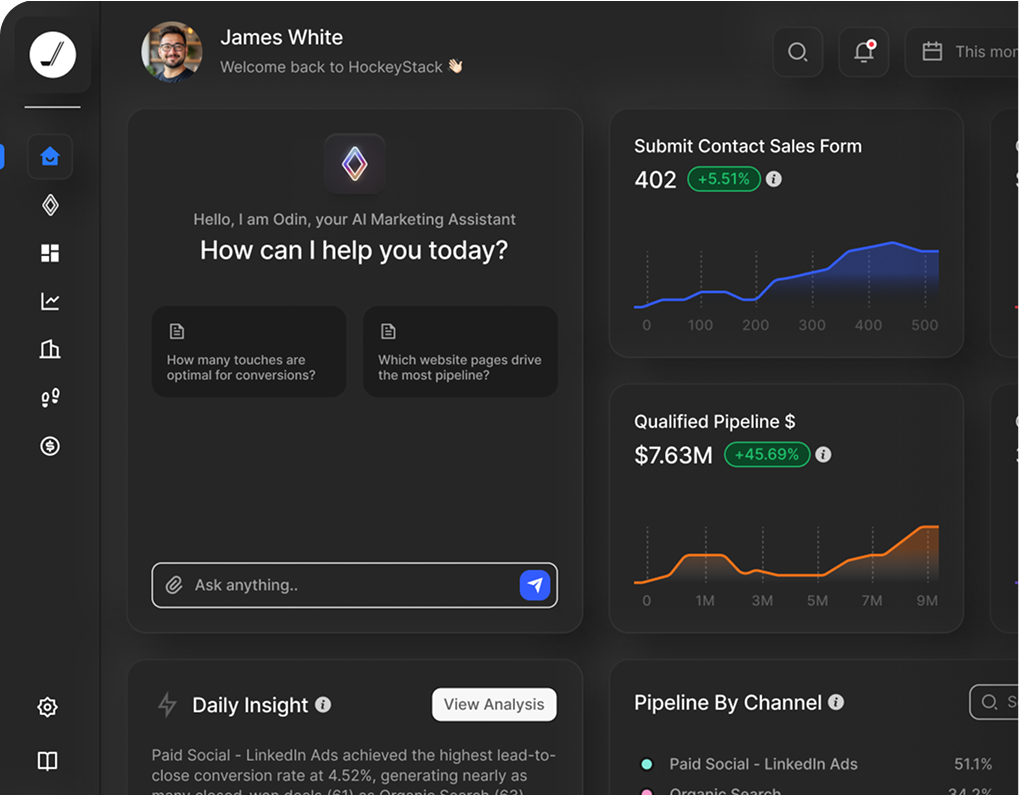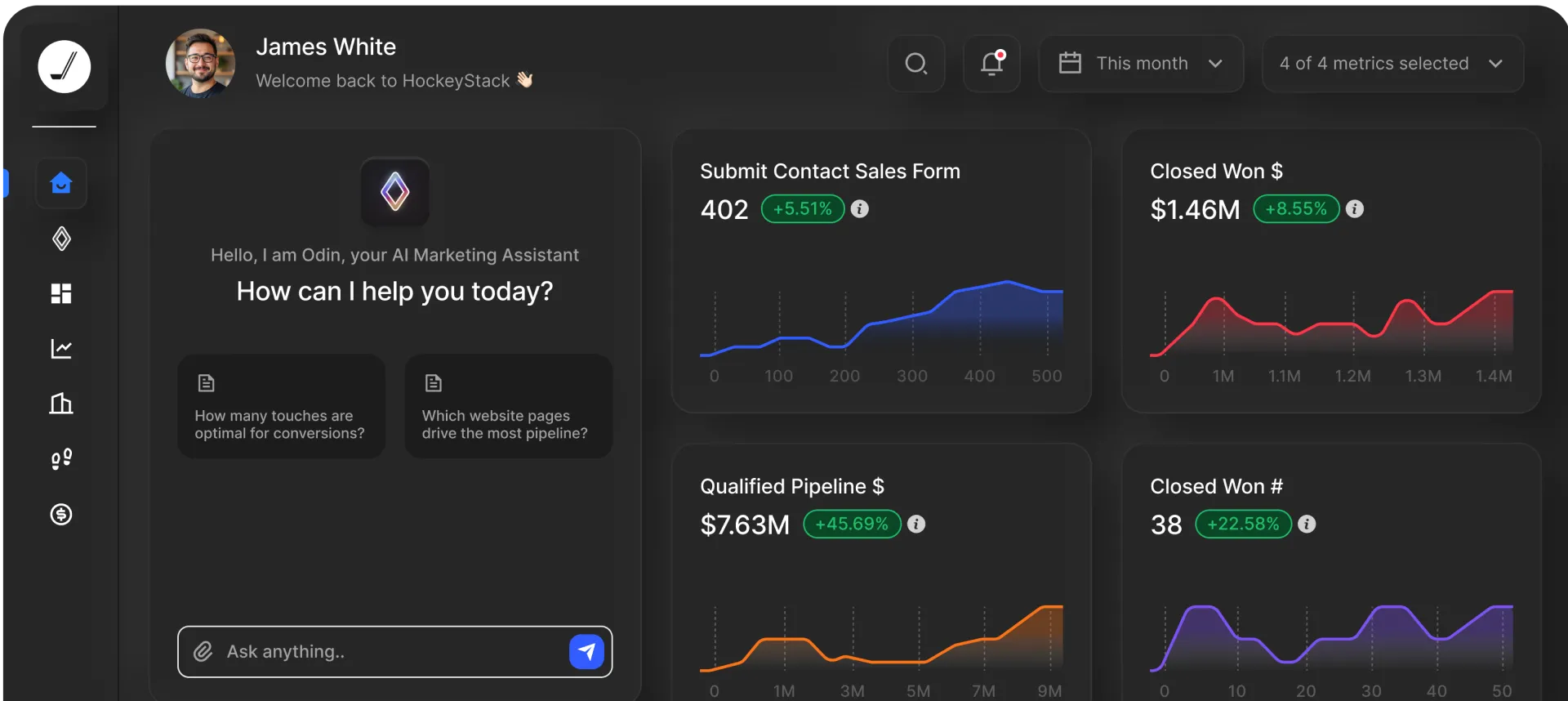Data-Driven vs Data-Informed: Which Approach Works for SaaS Marketing Teams?

Data-Driven vs Data-Informed: Which Approach Works for SaaS Marketing Teams?

Data has been a key factor in the success of industry giants like Uber and Google. Organizations today need data to inform decision-making, from the tracking of core indicators like revenue and churn rate to KPIs for individual teams. That said, unfortunately, many businesses do not make the most of available data because they do not use it correctly.

While there are numerous approaches to using data for decision-making, the two most common frameworks are data-driven decision-making and data-informed decision-making. In this article, I will discuss the key differences between the two approaches so that you can understand which is best for your organization.
Data-Driven Vs Data-Informed: What’s the Difference?
The term "data-driven" refers to a person or organization's decision-making process that incorporates data, or information that is kept and grounded in facts and numbers. As a result, data plays an important role in the company, as decision-makers rely heavily on it.
Data analysis and use is not only the responsibility of IT or data specialists; data is used and analyzed by all departments within the organization.
A data-informed approach, on the other hand, involves making decisions based on data as well as user research, experience, and personal insights. There is still a human element to decision-making rather than allowing data to control everything. Using the same example, you would not necessarily turn off one ad because of the lower CAC. Instead, you'd think about other factors and possibly adjust the ad accordingly.

The main distinction between the approaches is the extent to which data is used and valued in general.
A data-driven culture prioritizes data in your decision-making process, heavily weighting the numbers and metrics involved.
A data-informed culture is one in which data is used as one of many variables considered. Other factors typically include the context and behavior surrounding the data; however, this exposes decisions to bias or subjectivity.
What is the Data-Driven Approach?
The term data-driven refers to a business state in which data is used to power real-time decision-making and other related activities. Businesses that are data-driven arrive at their destination faster and more efficiently. Data-driven processes include high-quality data integration and algorithmic automation, including artificial intelligence (AI).
Data-driven means that data dictates the actions of those who carry out an event or process. This is most evident in the field of big data, where data and information are the foundation of all actions and data collection and analysis is the primary motivator. Because data is now easier to collect and store, big data analytics is gaining traction as the best technique for business decision-making.
Using past and current data, a data-driven approach can help us predict the future. Without data, we risk making incorrect assumptions and being swayed by biased opinions. Businesses today conduct big data analysis to establish themselves are industry leaders.

Many decision-makers make decisions based on theory or instinct. They sometimes use a few numbers to back up their decisions. However, how those numbers are interpreted remains subjective.
That is not the same in a data-driven strategy.
A data-driven strategy is based on data collection and analysis. It necessitates that your organization take a methodical approach. A quick glance at the sales figures or a set of website analytics isn't enough.
Without a systematic approach to data analysis, it's easy to succumb to unseen biases or assumptions.
It is much easier to optimize using a data-driven approach rather than relying solely on intuition. Data modeling techniques can provide a good estimate of the outcome. We tend to be fully aware of the required effort and investment before committing resources once we understand what data-driven means.
What Does it Mean to Be Data-Informed?
The ability to transform data into actionable insights in order to make decisions is referred to as data-informed decision-making. A data strategy, an analytics framework, a data literate workforce, diversity and inclusion, and a culture of collaboration, creativity, and communication are just a few of the critical capabilities that must be in place at the organizational level.
Making data-informed decisions requires systemic thinking, awareness of one's biases, the ability to challenge data, and the ability to accept failures and learn quickly from them.

Which Approach Should You Use for Your SaaS?
Both of the approaches have their own pros and cons for SaaS marketing analytics, so it’s essential to take a look at both data-driven and data-informed strategies in a bit more detail.
Benefits of data-driven: Many businesses appreciate the fact that they don't have to make decisions because the data tells them exactly what needs to be done.
Gut instincts are ignored, and there is no emotional component involved in data-driven strategies. It is also possible to work around the agendas of certain stakeholders. No stakeholder can argue otherwise if the business's approach is to listen to the numbers.
This approach is also considered proactive by many sources, including Harvard Business School. Rather than reacting to a market change, you can use data to identify something that may be problematic in the future.
Disadvantages of data-driven: The main issue with a data-driven approach, as previously discovered, is that the big picture is largely ignored. Furthermore, the approach is difficult to implement when a company does not generate enough data, to begin with.
When decisions are made based on small amounts of data, it is possible that the data is not representative of true conditions.
Furthermore, we cannot ignore the fact that becoming a data-driven business is difficult.
A data-driven organization will accept whatever the data says after it has been verified. As a result, being data-driven requires leadership to embrace whatever the data says, regardless of the data's results or returns.
This can be difficult for some people to accept when it contradicts what they want to believe or what they expect.
Benefits of data-informed: A data-informed approach, complete with creativity, intuition, and experience, assists a business in discovering unique solutions. We are almost limited by the obvious when we rely solely on data. With a more human touch, solutions are unique, and data is only used as one of many inputs.
Data-driven approaches can assist you in identifying trends. In the past, we've seen businesses become so focused on data that they lose sight of their competition or industry. In cases like these, it’s often seen that the target audience suddenly doesn’t understand the value of the product or service being provided any longer, and businesses lose out on customers.
With a data-informed approach, this issue does not exist.
Disadvantages of the data-informed approach: One issue that you may encounter when following a data-informed strategy is the attempted influence of particular stakeholders. When used incorrectly, decisions can be based on which stakeholders the company wishes to keep happy.
Furthermore, a data-informed approach frequently yields contradictory information. The opinions of team members will point to one thing, while the data will point to another. As a result, your company might be pulled in multiple directions, and the business can get torn apart at the very core.

Even the data-informed approach has some disadvantages.
On the one hand, we can look for trends and use the data to investigate the company's market position. On the other hand, it is impossible to draw absolute conclusions from the data, rendering it untrustworthy.
So, what is the best strategy to employ in light of all of this?
The answer for most businesses is to learn when to use each approach depending on the situation. There is no reason for any business to pick one strategy and stick with it for the rest of its life; instead, we must recognize the type of decision we are making. Some situations require data-driven strategies, while others require a data-informed approach.
Of course, there is no such thing as a perfect solution. Again, the human factor will always be a problem when making data-informed decisions. While your experience within an industry or role may help inform you in ways that data collection alone cannot, your decision-making may be influenced by your past experiences.
There are times and situations when being data-driven will help you, whereas the data-informed approach might be better in other situations. When your product and user base are more established, you have more insights to use to optimize your product with data-driven decisions.
When starting from scratch, especially with a disruptive product or new business model, there will be little historical data to draw from. Similarly, if you want to expand into new markets, relying on data from your existing audience may leave you blindsided. This is where data-informed leadership can truly provide a competitive advantage.

Using the two data approaches together will increase the number of relevant insights your teams require to do their jobs. The key is to understand when to use each one so that your expectations of the data match what you will get from it.
All two mindsets have a place; the key is knowing which one you require for a comprehensive SaaS marketing analytics strategy.
This brings us to the importance of data consolidation. The process of gathering all of your data from many sources across your organization, cleaning it up, and bringing it to one place, such as a cloud data warehouse or lakehouse environment, is known as data consolidation.
Consolidation of data is a critical step in the integration and data management processes. It quickly and easily makes all data management information available, and having all data in one place increases productivity and efficiency.
Having all of your data in one location makes it much simpler to get a comprehensive picture of your company. Additionally, it is much simpler to modify that data so that it may be used for reporting or analytics. Therefore, it's crucial to have all the data in one location before choosing between data-driven and data-informed tactics.
Marketing attribution tools like HockeyStack can help you with data consolidation.
Have you ever considered what consolidating inter-departmental data, visualizing your insights in funnels and dashboards, and tracking each customer touchpoint could mean for your business? You can create any dashboard you want with metrics from sales, marketing, revenue, and product in HockeyStack to get a unified view of your business.


In essence, data-driven firms simply use the data as is, while data-informed organizations are able to recognize its limitations and use the data more as a guide than anything else. Ultimately, your ability to operate data-driven or data-informed is determined by your resources, your objectives, and the actual data you have.
FAQs
Which is better: data-driven or data-informed? Finding a good balance between data-driven and data-informed methods is the best way to give your company a competitive edge. However, as previously stated, the method you will use will be determined by the circumstances. In general, you can use a data-driven approach whenever you need to make decisions based on quantitative input. If the decision requires some qualitative input as well, you can take the data-informed approach. It is entirely up to you what you do. Finally, you must recognize that there is no clear winner between the two approaches; it all depends on the specific situation.
What are examples of data-driven decision-making? Organizations will be able to better understand their workforce, manage talent lines more effectively, and retain performing employees with the help of data and analytics. To better understand "how to build a better boss," Google's people analytics teams dug deeper into their data and analyzed employee performance reviews and feedback surveys from multiple data sources.
This aided in the development of a list of data-driven insights into what employees value, as well as the improvement of managerial quality for 75% of their lowest-performing managers.
12 Best AI Tools for Lead Generation and Qualification in GTM
Find the right AI-powered lead generation tool for your GTM team. We researched 30+ platforms and ranked the top 12 for scoring, qualification, and automation.


Ready to see HockeyStack in action?
HockeyStack turns all of your online and offline GTM data into visual buyer journeys and dashboards, AI-powered recommendations, and the industry’s best-performing account and lead scoring.

Ready to See HockeyStack in Action?
HockeyStack turns all of your online and offline GTM data into visual buyer journeys and dashboards, AI-powered recommendations, and the industry’s best-performing account and lead scoring.



